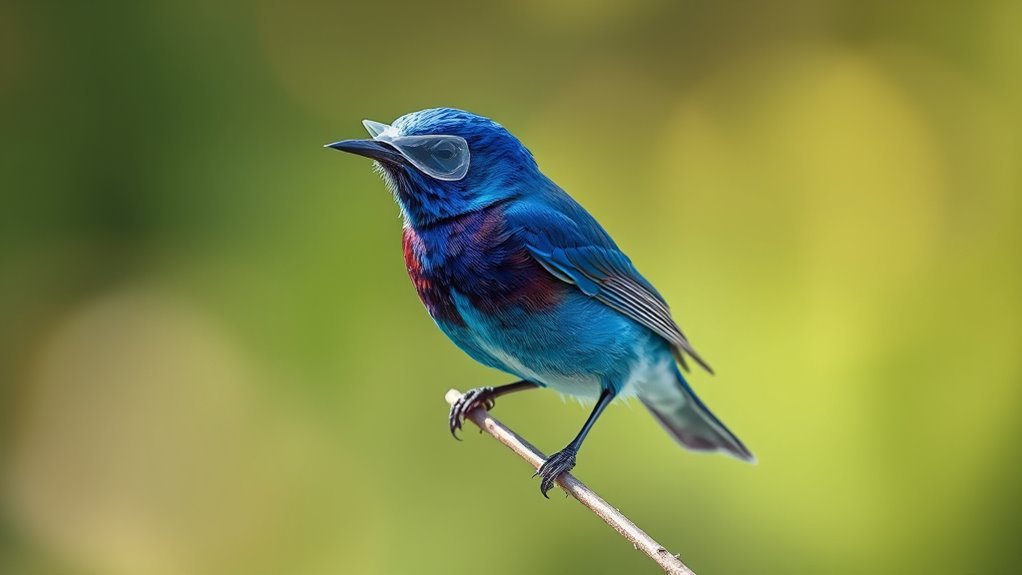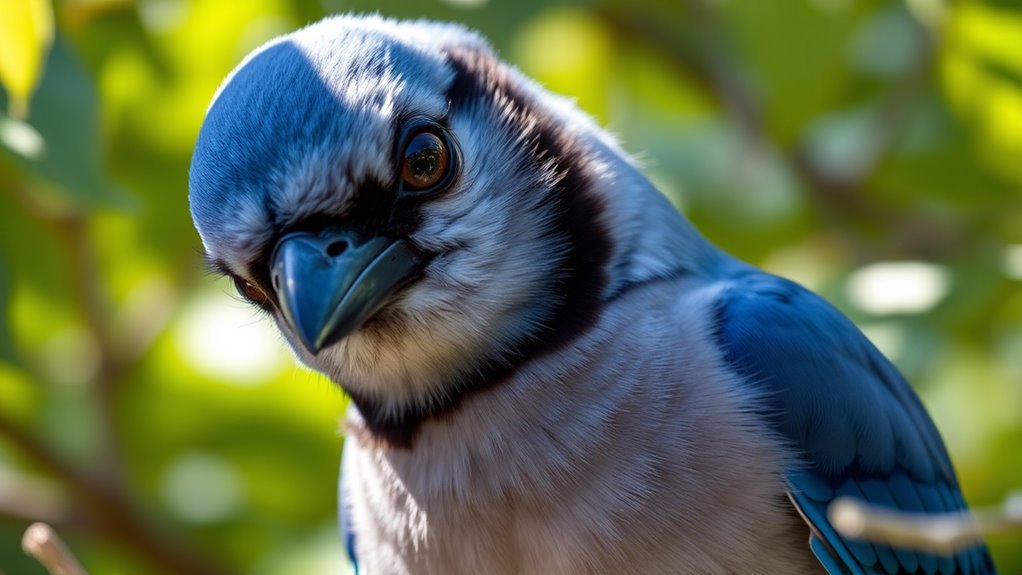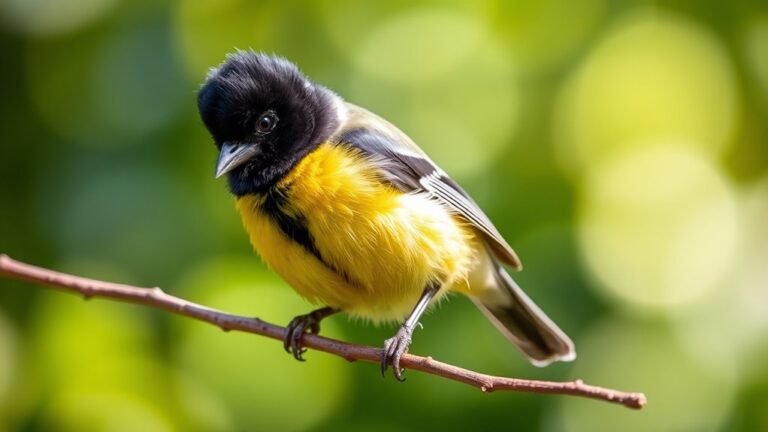Do Birds Blink Their Eyes?
Birds do not blink their eyes like humans. Instead, they have a special structure called a nictitating membrane. This membrane helps keep their eyes moist and protects them.
Birds have adapted to use this membrane for several reasons. It allows them to see clearly while still protecting their eyes from dust and debris. This adaptation is crucial for their survival, as good vision helps them find food and avoid dangers.
Understanding how birds manage eye health provides insight into their biology. The relationship between their vision and survival is important, showcasing how these adaptations support their daily activities.
Key Takeaways
- Birds do not blink their eyes like humans; they have a nictitating membrane for eye protection and moisture retention.
- The nictitating membrane covers the eye from the side and helps keep it moist, functioning similarly to eyelids.
- This adaptation allows birds to maintain clear vision without fully closing their eyes, even during flight.
- Birds can move their eyes independently, enhancing their ability to scan their environment without blinking.
- They utilize mucus secretion to maintain moisture on the eye surface, further reducing the need for traditional blinking.
The Anatomy of a Bird's Eye

The structure of a bird's eye shows how it adapts to its surroundings. Birds have many cone cells in their eyes compared to mammals. This allows them to see more colors and detect movement accurately.
Their large corneas and round lenses let in more light, providing a clear view of their environment. The placement of their eyes gives them a wide field of vision, important for finding food and avoiding danger.
These features help birds live successfully in various places, demonstrating a strong connection between their body structure and needs in nature.
Differences in Eye Structure: Birds vs. Humans
Birds and humans have different eye structures that serve unique purposes. Here are three main differences:
- Eye Shape: Bird eyes are rounder, which helps them see a wider area than human eyes.
- Color Vision: Birds have more types of photoreceptors. This allows them to see ultraviolet light, a spectrum invisible to humans.
- Nictitating Membrane: Birds have a third eyelid that protects the eye while still allowing them to see. Humans only have upper and lower eyelids.
These differences show how birds have evolved to adapt their vision to their environments. Understanding their eye structure gives us insight into how they interact with the world.
The Purpose of Blinking in Humans

Blinking is important for eye health and function. Each blink spreads a thin layer of tears over the eyes. This helps keep the eyes moist and prevents dryness.
Blinking also protects the eyes from irritants and removes debris, improving vision clarity. Additionally, blinking gives your eyes a brief rest, reducing strain during reading or screen use.
Understanding the value of blinking helps you appreciate this automatic process and its role in maintaining comfort and health for your eyes in daily life.
How Birds Keep Their Eyes Moist
Birds need moisture for their eyes, but they manage it differently than humans. Unlike humans, birds don't have eyelids. They use different methods to keep their eyes moist.
Here are three ways they do this:
- Nasal Glands: Birds have special glands that help them release excess salt. This process helps maintain fluid balance in their bodies and prevents their eyes from drying out.
- Mucus Secretion: Birds produce mucus in their eyes. This mucus keeps the eye's surface moist, which is important for clear vision and comfort.
- Habitat Choices: Many birds choose to live in areas near water or in environments with higher humidity. This behavior supports the health of their eyes.
These methods show how birds keep their eyes lubricated to maintain sharp vision, allowing them to thrive in different environments.
Nictitating Membrane: Nature's Protection

Many birds have a protective feature called the nictitating membrane. This clear membrane protects their eyes, keeping them moist and safe from dust and danger.
You may notice this membrane moving across a bird's eye, especially when it flies or hunts. Birds like eagles and ducks use this adaptation to improve their vision and protect against tough weather.
The nictitating membrane works like a natural shield, helping birds see better and react quickly. Learning about this feature highlights the amazing ways birds adapt to their environment.
Eye Movements and Vision in Birds
Birds have unique eye movements and vision. Their adaptations help protect their eyes and improve their ability to see. Here are some key points:
- Independent Eye Movement: Birds can move their eyes in different directions. This lets them see a wider area to spot predators and prey.
- Enhanced Color Vision: Many birds can detect ultraviolet light. This skill helps them find food and choose mates.
- Quick Saccades: Birds make fast eye movements to quickly scan their surroundings. This ability is important for their survival.
These features show how birds have adapted their vision for various habitats.
Understanding how they see the world can deepen our appreciation for these creatures.
The Role of Feathered Eyelashes
Birds have feathered eyelashes that protect their eyes. These feathers serve important functions beyond beauty. They act as barriers, keeping dust, debris, and irritants away from the eyes, which helps maintain clear vision. This protection is vital during flight, where wind and particles can pose risks.
Feathered eyelashes also help retain moisture, preventing dryness. Birds with well-developed eyelash features have an advantage, as these adaptations support their health and survival.
Adaptations for Hunting and Navigation
Birds have unique ways to hunt and move through different environments. Their skills for hunting and moving around are impressive. Here are some key strategies they use:
- Sharp Eyesight: Birds can see very well. They spot movements and colors that humans can't see, which helps them find food easily.
- Awareness of Space: Birds like hawks and peregrine falcons know their surroundings well. They can fly accurately and know where to find their prey.
- Communication Signals: Many birds use sounds and body movements to talk to each other. This helps them work together while hunting and moving around.
These adaptations make birds skilled hunters and navigators, allowing them to thrive in their habitats.
The Importance of Vision in Bird Behavior
Vision is crucial for bird behavior. It affects activities like foraging and social interactions. Birds use their sharp eyesight to find food. For example, raptors can see small animals from far away, which helps them hunt effectively.
In social situations, vision supports communication. It allows birds to recognize mates, evaluate rivals, and understand flock dynamics. Color vision helps them choose partners and identify group members.
When you watch birds in their environments, you'll see how closely their actions connect to visual signals. This shows that vision is vital for survival and for building social bonds in bird communities.
How Environmental Factors Affect Bird Eyes
Birds adapt their eyes to their environments. They face many changes in vision due to light levels and habitat conditions. Several factors affect a bird's eyesight:
- Seasonal Changes: Birds change their vision based on light and food throughout the year.
- Temperature Fluctuations: Extreme weather can harm their eyes and affect their vision, making it harder to hunt or find food.
- Air Quality: Poor air quality in cities can reduce a bird's ability to see clearly.
Common Eye Problems in Birds
Birds can face various eye problems that affect their health. Common issues include eye infections, such as conjunctivitis, which can cause redness and discharge.
Visual problems may arise from cataracts or retinal disorders. Inflammation can occur from irritants or infections, making it hard for birds to feed and move.
Ocular parasites can also affect birds, leading to discomfort and possible blindness. Additionally, corneal ulcers may develop if the eye's surface is injured, requiring quick attention.
Understanding these common eye issues helps you care for birds and keep their vision clear.
Fascinating Facts About Bird Vision
Birds have amazing vision that often exceeds human abilities. Their eyes are adapted for diverse environments. Here are some interesting facts about how birds see:
- Color Vision: Birds can see more colors than humans. They can detect ultraviolet light. This ability affects how they behave and choose mates.
- Depth Perception: Many birds have eyes on the sides of their heads. This position gives them a wide field of view, which helps them notice movement.
- Eye Colors: Birds have various eye colors, like gold or bright blue. These colors can influence how they interact with their environment and other animals.
These unique aspects of bird vision show us how they experience their surroundings.
Frequently Asked Questions
Do All Bird Species Have the Same Eye Structure?
Bird species do not all have the same eye structure. Each species has unique eye anatomy that affects vision. These differences help birds adapt to their environments and improve their hunting strategies. Understanding these variations reveals how each bird fits into its ecological niche.
How Do Birds Protect Their Eyes From Debris?
Birds protect their eyes from debris using several methods. They have a special eye feature called the nictitating membrane. This membrane acts like a windshield wiper, sweeping away dust and particles. It helps keep their vision clear, which is important for survival. These adaptations allow birds to thrive in different environments while safeguarding their eyesight.
Can Birds See in the Dark?
Most birds cannot see well in the dark. However, some nocturnal birds have special features that help them. These birds possess more rod cells in their eyes, which make it easier to see in low light. This allows them to hunt and move around at night effectively.
Do Birds Have Color Vision Like Humans?
Birds have excellent color vision. They can see a broader range of colors than humans, including ultraviolet light. This ability helps them find food, choose mates, and spot predators. Their strong color perception connects them closely to their environment and influences their behavior.
How Do Birds Perceive Motion and Depth?
Birds have excellent vision. Their binocular vision helps them see depth clearly. This ability allows them to judge distances accurately. Birds also have advanced motion detection skills. They can quickly sense movement around them. This quick reaction helps them stay safe in their environment. Overall, these visual skills improve their chances of survival.

Hello, I’m Emily Price, the founder of Birds Affection. As a passionate bird enthusiast and spiritual seeker, I’ve always been fascinated by the symbolic meanings and mystical connections between birds and our lives. On this website, I share my knowledge and insights on the spiritual significance of various bird species, exploring their roles as messengers, guides, and teachers. Through my writing, I aim to inspire and educate others on the profound wisdom and beauty that birds bring to our world. Join me on this journey as we delve into the enchanting realm of bird symbolism and discover the hidden meanings behind these magnificent creatures.







